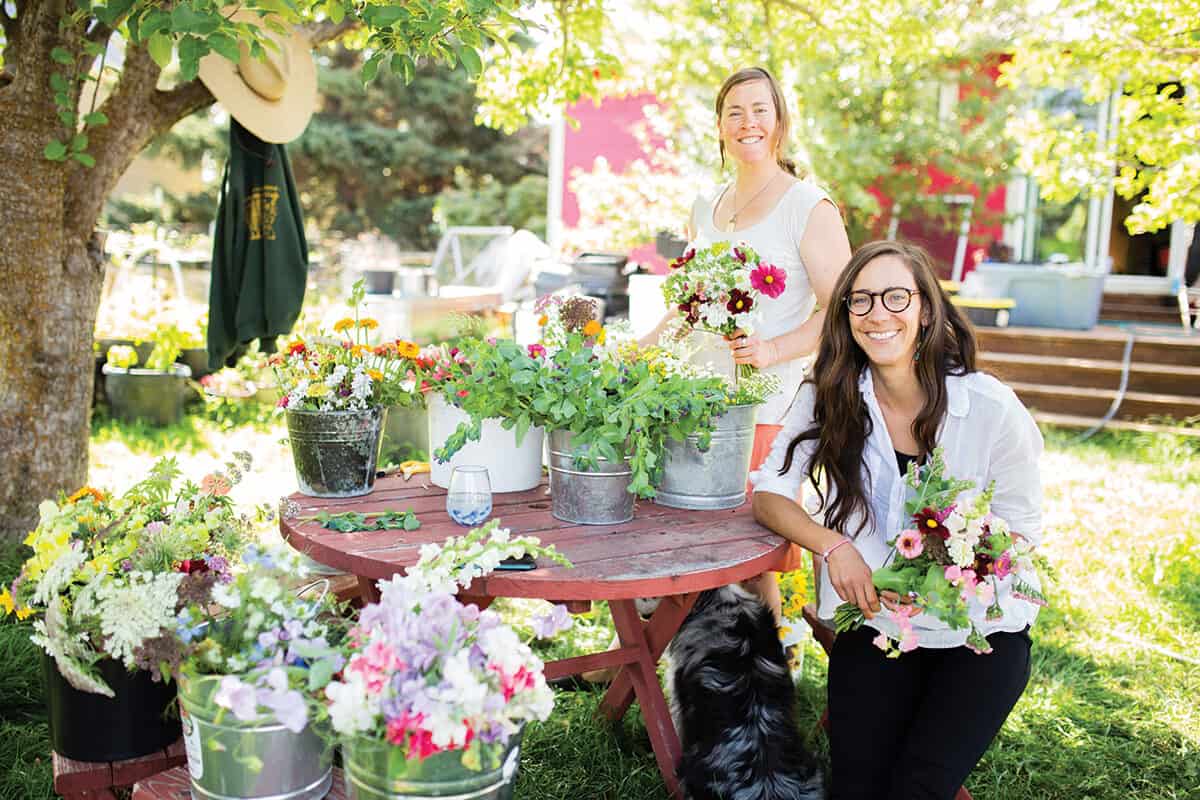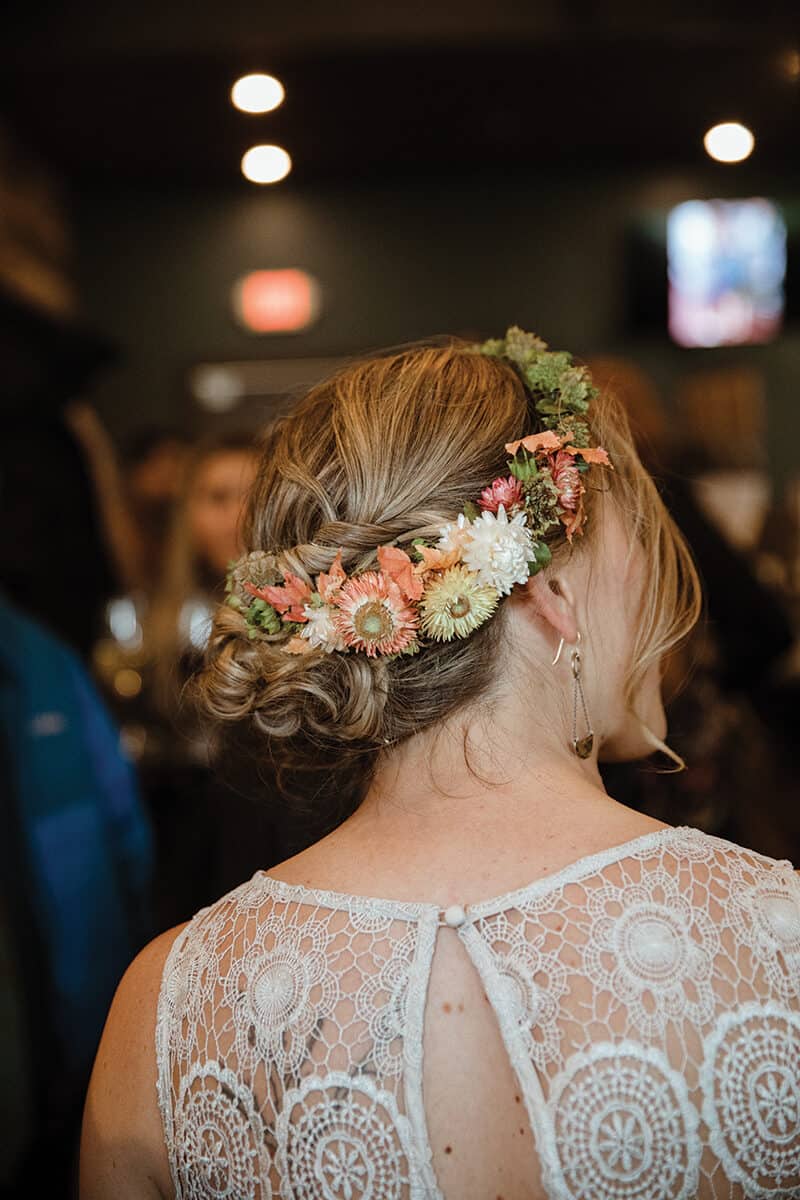FROM GARDEN TO VASE WITH RED HOUSE FLOWERS
FROM GARDEN TO VASE
WITH RED HOUSE FLOWERS

In a fast-paced culture aimed at getting what you want when you want it, it’s sometimes hard to slow down enough to make purposeful wedding decisions. Yet, spending time on mindful details—like serving seasonal food, minimizing landfill waste, and attentively choosing your flowers—renders an unforgettable showcase of thought and gesture.
That’s where the intentionality of the slow flower, or field-to-vase, movement comes in. This practice—in which flowers are grown or sourced locally and hand-delivered by the actual farmer—differs from traditional florist offerings, and showcases the alternative ways some farmers and designers approach the wedding industry.
“I compare the slow flower movement to the slow food movement,” explains Katie Knipe, designer for Red House Flowers in Victor, Idaho. “Yet, unlike food, there are very few regulations in the flower industry regarding the use of chemicals and worker conditions. … Choosing flowers [for your wedding] that are local and organically grown shows support for a healthier industry.”
Emily Sustick, a former community-supported agriculture farm worker, farm-to-school educator, and co-owner of Red House Flowers, always had an affinity for blooms. “I remember hauling in the veggies and passing by the flower beds at Snowdrift Farms thinking, ‘I wish I was on the flower team.’”

Then, in the winter of 2017, Sustick tore her ACL skiing. Surfing the internet during the resulting couch time, she stumbled across Erin Benzakein of Floret, a small family-operated flower farm in Skagit Valley, Washington. “I was re-inspired,” says Sustick. She bought seeds, grew different flower varieties in her backyard that spring, and brought her collection to the People’s Market in Jackson that same fall. Word got out, causing Knipe, Linn Canyon Ranch’s gardener and designer, to reach out to Emily for flowers for a friend’s wedding. That’s when the light bulb went off for Sustick.
“Katie had a different skill set than I, making her the perfect teammate for a slow-flower business,” she recalls.
The two officially launched their partnership in 2019 with a clear mission: to reduce the floral industry’s carbon footprint. But the partners had a secondary vision, too, which included tapping into the potential of working with freshly cut flowers, as certain varieties cannot withstand shipping.
Sustick’s “backyard garden” consists of two greenhouses and four raised beds where the Red House ladies grow annuals like tulips, sweet peas, dahlias, mums, and zinnias. A few perennial beds offer flowers such as peonies, rudbeckia, speedwells, and pincushions, and they also forage for hops, berries, and apple blossoms. Some of the flowers grown are not well known and act as filler to create balanced arrangements. Others—like chrysanthemums—can come with an unattractive stigma. Still, the heirloom varieties Sustick grows and Knipe uses in her arrangements don’t look like your typical grocery store chrysanthemum, often eliciting comments like: Are those really mums?

Together, Sustick and Knipe create anything from delicate wearables to elaborate installations while upholding their values by reducing, reusing, and going foam-free whenever possible. “Traditional floral foam is technically a by-product of a chemical reaction,” explains Knipe. A reaction that includes the constituents of formaldehyde (a known carcinogen), barium sulfate, and carbon black (a material produced through the incomplete combustion of heavy petroleum products). Floral foam is full of microplastics, misleadingly marketed as “biodegradable,” and is often used in wasteful proportions in wedding preparations.
For large, ornate installations, Red House Flowers uses reusable materials, like water tubes and chicken wire, instead of foam. The team creates what Sustick and Knipe call a “moss burrito” by placing moss inside a rolled-up chicken-wire form and using water tubes to secure the flowers and hydrate them throughout the event. The infrastructure remains invisible to admirers. Then, once the wedding is over, the moss, wire, and tubes are saved for use in another installation and the rest is composted.

In lieu of purchased vases that are often discarded or sent to the thrift store after festivities are over, Sustick and Knipe supply recycled vases as part of their wedding packages. This offering is not only sustainable, but also provides budget-savvy couples a way to cut costs on their décor. This year, the women will also offer an option for “flower waste disposal,” which involves composting. “It was important for us to address these items so that we could feel really good about being part of this industry,” explains Sustick. “We encourage other florists to examine the alternatives, as well.”
But it’s not just sustainability that keeps the pair motivated. Knipe has a knack for accentuating a sense of place through big flower installations made with local and regional varieties. She also enjoys the intricacies of little items like boutonnieres, corsages, and flower crowns. “The wearables are the most fun [to create] because of the tiny details I get to put into them,“ she says, “ones that are noticeable to the people who get to wear them. Plus, they show up in pictures!”

For Sustick, the mere fact that flowers make people smile fills her up the most as a farmer. “Even if people don’t buy our flowers at the market, there’s something special that happens when they see them,” she says. “We get that same response from the brides when we deliver flowers to weddings. It certainly adds fuel to our fire.”
—
Red House Flowers operates seasonally from June through September with limited offerings in the offseason. Learn more about them at redhouseflowers.com.
SLOW FLOWER TIPS:
1. Use local, seasonal flowers whenever possible. “Couples often get married in the Tetons because the place means something to them,” explains Sustick. “Using local flowers helps guests celebrate the uniqueness of place—it’s an extension of the natural world.”
2. Since floral design is an art form, be open to the process. “Try to focus on the color palette and feel that you want for your arrangements, rather than the type of flowers used,” says Knipe. This gives a farmer-florist more freedom.
3. Knipe thinks it’s important to plan for a big statement piece—something that welcomes guests when they walk in. Think about that concept when choosing the placement of flowers, too. “Where do you want people to see and feel [the love] the most?” asks Sustick.
